Japan Wood Products
Prices
Dollar Exchange Rates of
11th August 2014
Japan Yen 102.2
Reports From Japan
Japan’s GDP drops as expected
Gross Domestic Product (GDP) in Japan contracted 1.70
percent in the second quarter of 2014 over the previous
quarter, the steepest drop since the 2011 earthquake.
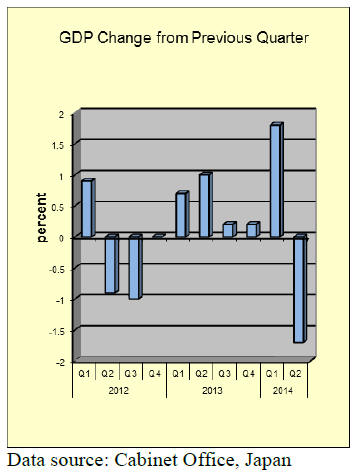
The decline in GDP was much as anticipated since
economic activity suffered a set-back after the
consumption tax rise in April this year.
Analysts now expect swift action by the Bank of Japan to
provide an additional boost to the economy.
Consumer confidence index holds onto recent gains
The latest consumer confidence survey was conducted on
15 July and Japan‟s Cabinet Office has just released the
results which show the index rose 0.4 point to 41.5, the
third monthly increase.
However the pace of increase slowed compared to the
previous month and was below levels for the same month
a year earlier.
Those surveyed were slightly more optimistic on the
prospects for the economy on three of the four categories
in the survey - overall economic well-being, income
growth and job prospects, but the sub-index on time to buy
durable goods remained unchanged.
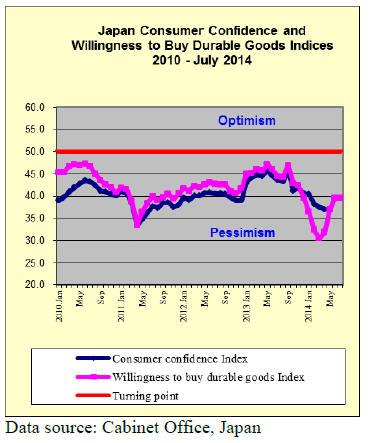
Machinery orders signal slow economic recovery
Details of machinery orders, a key indicator of capital
spending by Japanese companies, has been released by the
Cabinet Office.
See:
http://www.esri.cao.go.jp/en/stat/juchu/juchu-e.html
For the first time in three months machinery orders rose in
June after a steep fall in May. But with export growth
remaining weak and with subdued industrial output and
consumer spending the short-term outlook for the Japanese
economy is of concern especially coming on the heels of
the fall in GDP growth for the second quarter.
June 2014 machinery orders rose only 8.8% following a
record 20% fall in May however the consensus is that the
economy will resume a moderate recovery in the third
quarter.
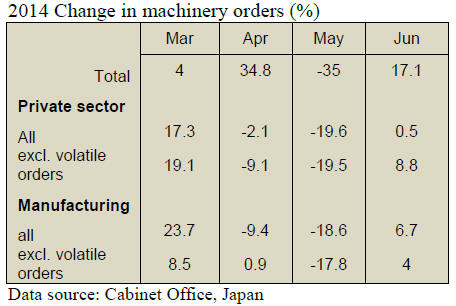
June housing starts – better than forecast
June housing starts data from Japan‟s Ministry of Land,
Infrastructure and Transport show that, while there was an
improvement over levels in the previous month, year-onyear
starts are around 9% down.
However, many analysts had expected figures somewhere
in the region of minus 12%.
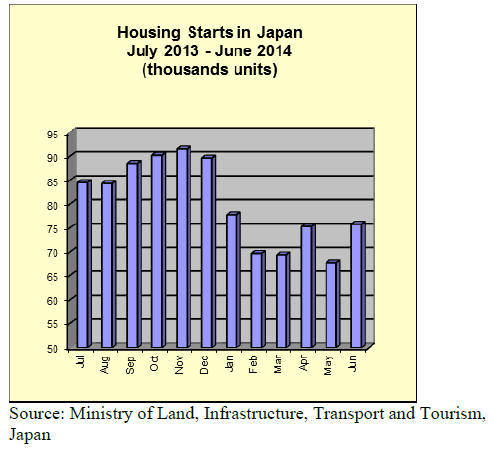
Yen strengthens but then falls back
At its latest meeting the Bank of Japan (BoJ) maintained
its stance and kept monetary policy unchanged saying it
will continue its yen 60-70 trillion annual asset buying but
it did warn of the risks from declining exports and slowing
industrial output.
The impact of the BoJ assessment of the economy and its
response was largely expected so there was not much
impact on the yen which has been trading in a narrow band
all year. The greatest impact has come from investors
seeking a safe haven in response to fighting in Ukraine
and Gaza which lifted the yen at the beginning of the
month.
One worrying piece of information from the BoJ was that,
on an annual basis, housing loans in Japan rose 2.7% in
the second quarter compared to a rise of 2.9% recorded in
the preceding quarter.
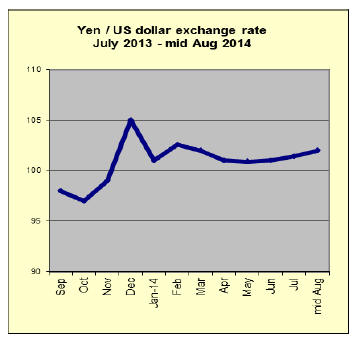
For the JLR report please see:
http://www.nmokuzai.
com/modules/general/index.php?id=7
Imported South Sea (tropical) hardwood plywood
The largest supplier in Malaysia announced price hike
since July on 12 mm concrete forming panel. Malaysian
suppliers are all bullish since log prices stay up high even
in full logging season.
In Japan, the market has been slackening with slower
demand but facing strong supply side proposals, the
importers and wholesalers have started stopping
underselling.
In Sarawak, Malaysia, dry weather continues and water
level in rivers dropped, which hampers log transportation.
By limited log supply and India‟s aggressive purchase
after Myanmar banned log export, log prices stay up high
so local plywood mills have to pay high log prices. Then
Islamic fast for a month in late June and Islamic New Year
in late July slowed log production.
The largest supplier proposed $15 per cbm price increase
for July shipment. In late June, the export prices of
concrete forming panel was unchanged at about $560-565
per cbm C&F.
Other plywood suppliers in Malaysia have the same high
log price problem so their proposal is high with less offer
volume. Indonesian concrete forming panel suppliers
enjoy robust orders from the Middle East so they would
not listen to weak Japan prices.
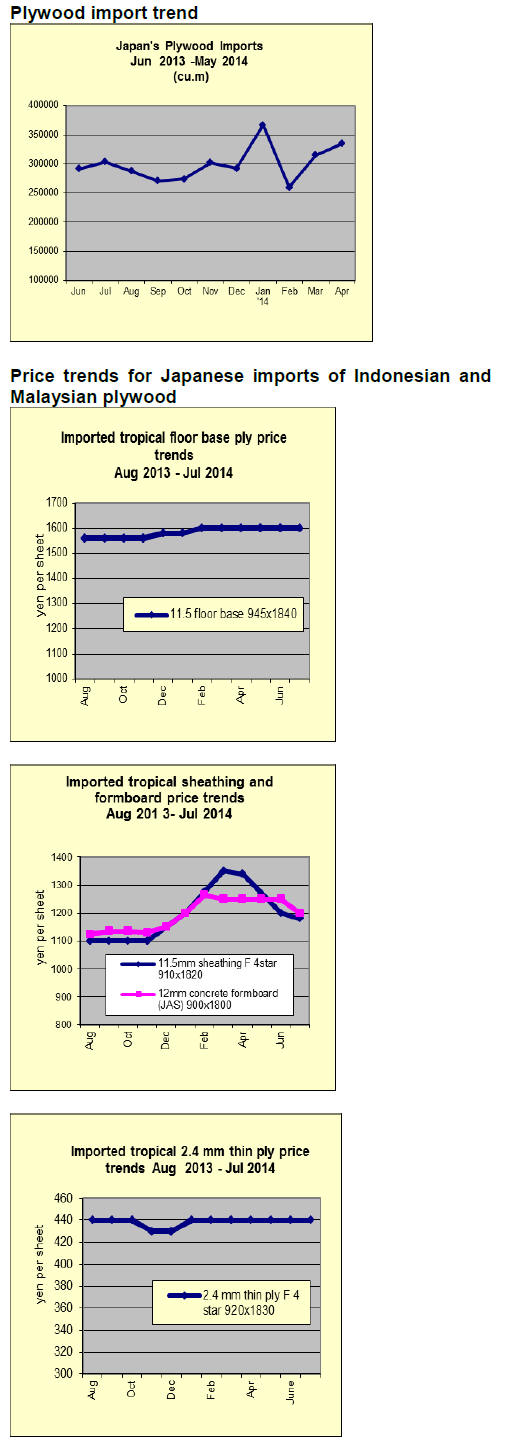
In Japan, with slow shipments, port inventories are still
high but future arrivals will decline so the marketers see
that the supply and demand are estimated to balance out
probably in September. Since the importers have curtailed
future purchases, they need to start purchasing cargoes of
September and on.
South Sea (tropical) logs
After Myanmar stopped log export, India had to increase
log purchase from Malaysia, particularly hardwood
species like keruing and kapur, for plywood mills. India‟s
domestic demand is getting strong and at the same time,
their currency is getting strong so their purchase is more
powerful and vigorous now.
Export prices of keruing and kapur for plywood climbed
by $20-30 in recent weeks. Prices of other species are also
pushed up by $5-10. Meranti regular prices for Japan
market is edging up to US$290-295 per cbm C&F.
Log importers in Japan are tired of rising prices since the
demand in Japan is stagnant and it is difficult to cover the
higher cost. MLH log prices for crating are US$195-200,
US$5-10 higher than last month.
In PNG and Solomon Islands, weather continues foul with
continuous rain so the log production is slow and there are
many ships waiting for logs. Chinese buyers are asking to
reduce log prices since log prices are dropping in China.
Acceptance of foreign workers
The Ministry of Land, Infrastructure and Transport made a
public notification for acceptance of foreign labor.
Specifically, as an emergency measures to have foreign
workers in construction field, it shows specific
requirement for accepting construction companies and
administration groups.
The Ministry will invite public comments until July 25
then it will be officially announced in early August and it
will go into effect in April 2015. This is measures with
limited period to deal with increasing construction works
for next Olympic Games in 2020. This makes it possible to
accept experienced foreign workers smoothly.
Accepting number is up to total regular workers of
accepting companies have and wage must be more than
the Japanese workers with the same skill.
Trends in wood drying
There is growing demand for dried wood for construction
since dried wood has clear strength performance with less
cracking and curving after applied in building. According
to the Ministry of Agriculture, Forestry and Fisheries,
lumber shipment in 2013 was 10,100,000 cbms, 8.6%
more than 2012.
Building materials and engineering works construction
materials, which takes 80% of lumber shipment, increased
by more than 10%. Meantime, that for furniture, fittings,
crating and boxing dropped little from previous year.
In this, shipment of kiln dried lumber was 2,984,000 cbms,
8.7% more and the share of KD lumber was 29.54% from
29.49% in 2012.
Back in 2002, share of kiln dried lumber was only 12.4%
so in last ten years, it grew by 17.1 points to almost
30%.The largest reason is high housing starts in 2013,
10.6% more than 2012 so total wood demand increased.
Also the government set a target of achieving 50% of
wood self-sufficiency rate by 2020 and large house
builders promoted using domestic species and preferred
using kiln dried lumber.
Another topic of wood drying is drying large size lumber,
laminated lumber and CLT since there are increasing
number of large wooden buildings. Also with increasing
number of biomass power generation facilities in relation
to FIT system, drying wood chip quickly and
economically becomes important issue from now on.
By type of energy source for drying, steam is the most
popular then gas burning. Hot water and electric follow.
Size of chamber is becoming larger as more drying
demand for lamina and stud is increasing.
|